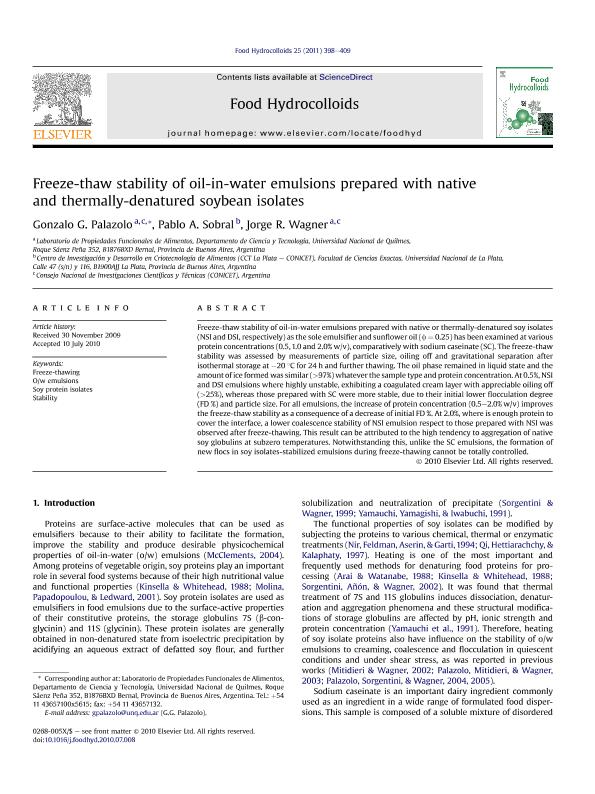Mostrar el registro sencillo del ítem
dc.contributor.author
Palazolo, Gonzalo Gastón

dc.contributor.author
Sobral, Pablo Antonio

dc.contributor.author
Wagner, Jorge Ricardo

dc.date.available
2023-03-06T15:47:32Z
dc.date.issued
2011-04
dc.identifier.citation
Palazolo, Gonzalo Gastón; Sobral, Pablo Antonio; Wagner, Jorge Ricardo; Freeze-thaw stability of oil-in-water emulsions prepared with native and thermally denatured soybean isolates; Elsevier; Food Hydrocolloids; 25; 3; 4-2011; 398-409
dc.identifier.issn
0268-005X
dc.identifier.uri
http://hdl.handle.net/11336/189695
dc.description.abstract
Freeze-thaw stability of oil-in-water emulsions prepared with native or thermally-denatured soy isolates (NSI and DSI, respectively) as the sole emulsifier and sunflower oil (φ = 0.25) has been examined at various protein concentrations (0.5, 1.0 and 2.0%. w/v), comparatively with sodium caseinate (SC). The freeze-thaw stability was assessed by measurements of particle size, oiling off and gravitational separation after isothermal storage at -20°C for 24. h and further thawing. The oil phase remained in liquid state and the amount of ice formed was similar (>97%) whatever the sample type and protein concentration. At 0.5%, NSI and DSI emulsions where highly unstable, exhibiting a coagulated cream layer with appreciable oiling off (>25%), whereas those prepared with SC were more stable, due to their initial lower flocculation degree (FD %) and particle size. For all emulsions, the increase of protein concentration (0.5-2.0%. w/v) improves the freeze-thaw stability as a consequence of a decrease of initial FD %. At 2.0%, where is enough protein to cover the interface, a lower coalescence stability of NSI emulsion respect to those prepared with NSI was observed after freeze-thawing. This result can be attributed to the high tendency to aggregation of native soy globulins at subzero temperatures. Notwithstanding this, unlike the SC emulsions, the formation of new flocs in soy isolates-stabilized emulsions during freeze-thawing cannot be totally controlled.
dc.format
application/pdf
dc.language.iso
eng
dc.publisher
Elsevier

dc.rights
info:eu-repo/semantics/openAccess
dc.rights.uri
https://creativecommons.org/licenses/by-nc-sa/2.5/ar/
dc.subject
FREEZE-THAWING
dc.subject
O/W EMULSIONS
dc.subject
SOY PROTEIN ISOLATES
dc.subject
STABILITY
dc.subject.classification
Alimentos y Bebidas

dc.subject.classification
Otras Ingenierías y Tecnologías

dc.subject.classification
INGENIERÍAS Y TECNOLOGÍAS

dc.title
Freeze-thaw stability of oil-in-water emulsions prepared with native and thermally denatured soybean isolates
dc.type
info:eu-repo/semantics/article
dc.type
info:ar-repo/semantics/artículo
dc.type
info:eu-repo/semantics/publishedVersion
dc.date.updated
2023-03-05T15:34:28Z
dc.journal.volume
25
dc.journal.number
3
dc.journal.pagination
398-409
dc.journal.pais
Países Bajos

dc.journal.ciudad
Amsterdam
dc.description.fil
Fil: Palazolo, Gonzalo Gastón. Universidad Nacional de Quilmes. Departamento de Ciencia y Tecnología; Argentina. Consejo Nacional de Investigaciones Científicas y Técnicas; Argentina
dc.description.fil
Fil: Sobral, Pablo Antonio. Provincia de Buenos Aires. Gobernación. Comisión de Investigaciones Científicas. Centro de Investigación y Desarrollo en Criotecnología de Alimentos. Consejo Nacional de Investigaciones Científicas y Técnicas. Centro Científico Tecnológico Conicet - La Plata. Centro de Investigación y Desarrollo en Criotecnología de Alimentos. Universidad Nacional de La Plata. Facultad de Ciencias Exactas. Centro de Investigación y Desarrollo en Criotecnología de Alimentos; Argentina
dc.description.fil
Fil: Wagner, Jorge Ricardo. Universidad Nacional de Quilmes. Departamento de Ciencia y Tecnología; Argentina. Consejo Nacional de Investigaciones Científicas y Técnicas; Argentina
dc.journal.title
Food Hydrocolloids

dc.relation.alternativeid
info:eu-repo/semantics/altIdentifier/url/https://www.sciencedirect.com/science/article/abs/pii/S0268005X10001463
dc.relation.alternativeid
info:eu-repo/semantics/altIdentifier/doi/http://dx.doi.org/10.1016/j.foodhyd.2010.07.008
Archivos asociados
